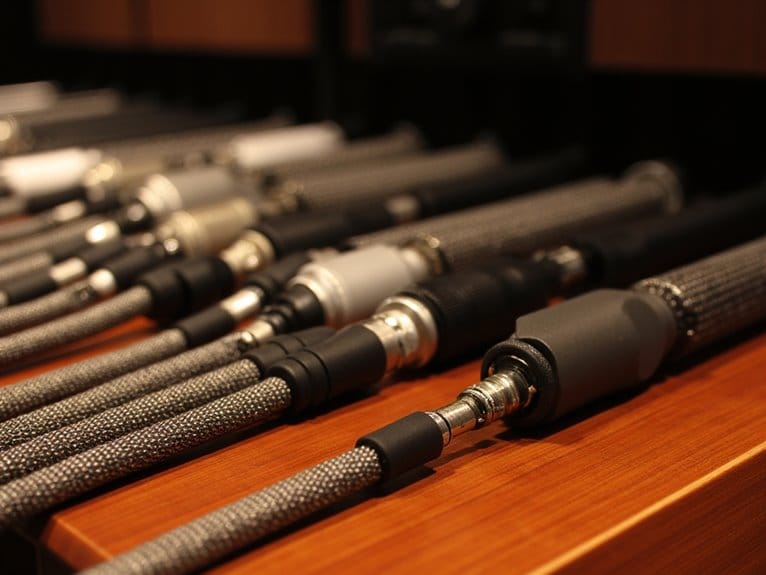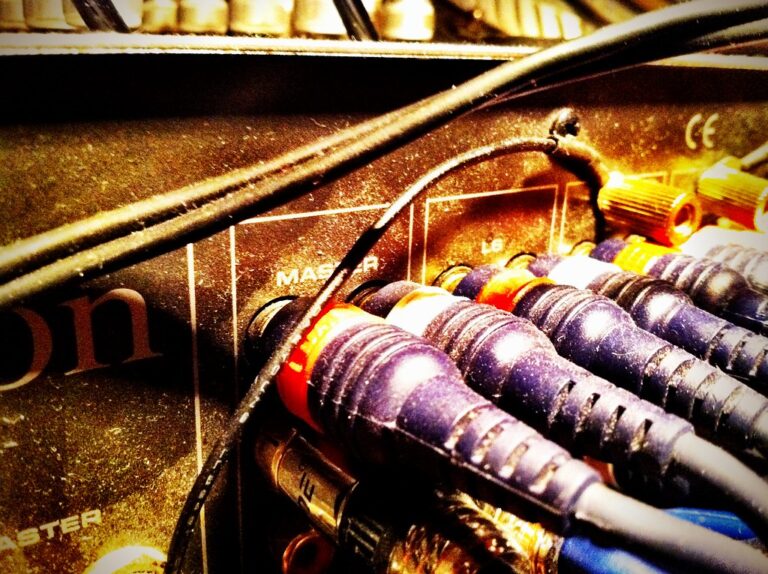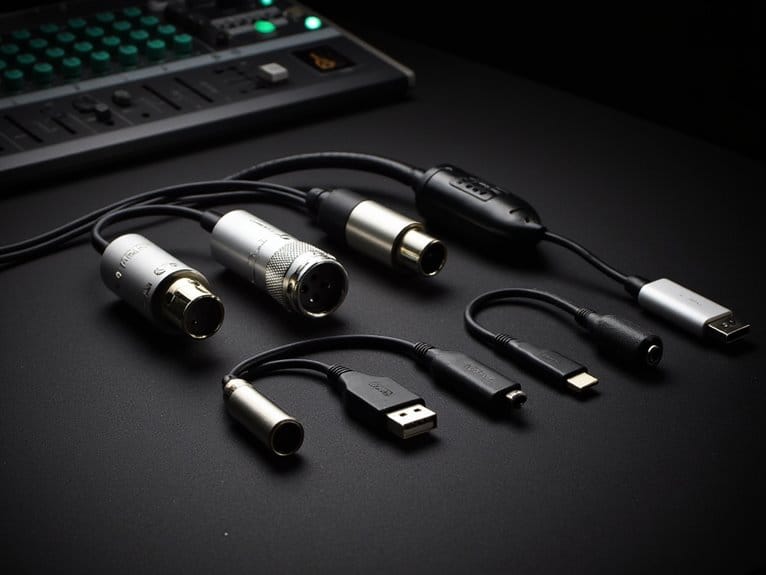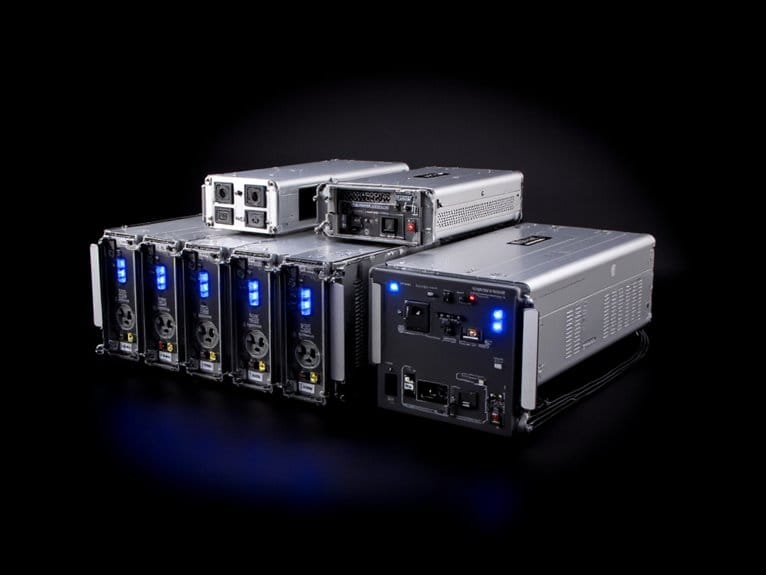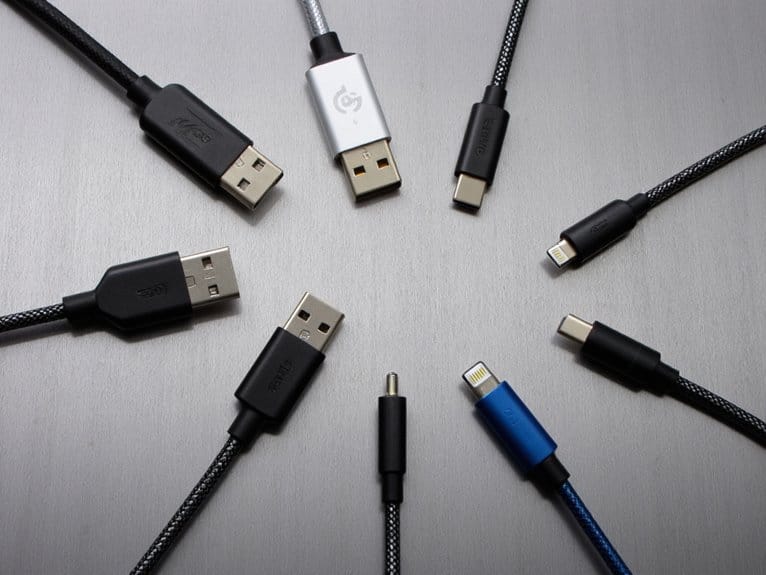10 Best Audio Cable Tester
I’ve found the Mackie MTest-1 consistently delivers reliable pin verification across multiple connector types, while the MFL Detachable Advanced stands out for its two-piece design that handles through-wall testing scenarios. The Behringer CT100 offers microprocessor-controlled diagnostics in a pocket-sized form, though you’ll need to supply batteries. For signal generation capabilities, the Xvive AT-1 combines phantom power testing with audio signal output, and the Elite Core OSP CT-04C provides straightforward plug-and-test operation with robust metal construction that survives fieldwork abuse better than plastic alternatives.
We are supported by our audience. When you purchase through links on our site, we may earn an affiliate commission, at no extra cost for you. Learn more.
Notable Insights
- Mackie MTest-1 offers reliable pin verification for multiple connector types, making it ideal for live sound applications.
- MFL Detachable Advanced Cable Tester features a two-piece design enabling through-wall testing without disconnecting pre-installed cables.
- Behringer CT100 provides microprocessor-controlled testing with multiple modes in a compact, pocket-sized design for portability.
- Xvive AT-1 combines diagnostic capabilities with phantom power testing and audio signal generation in one portable unit.
- Elite Core OSP CT-04C delivers simple plug-and-test operation with robust metal construction for professional durability requirements.
Mackie Cable Tester (MTest-1)

If you’re a live sound engineer, studio technician, or someone who regularly builds custom cables, the Mackie MTest-1 represents that reliable workhorse you didn’t know you needed until cable failures start disrupting your workflow. This battery-powered unit tests virtually every connector you’ll encounter, including XLR, TRS, TS, RCA, speakon, MIDI, and 3.5mm connections, using a straightforward 5-way switch for pin verification and continuity testing. Weighing just 1.4 pounds with tank-like construction, it’s designed for portability without sacrificing durability. The bright LED indicators effectively identify cable issues, though some users suggest covering them to prevent glare during darker venue setups.
Best For: Live sound engineers, studio technicians, and anyone who regularly builds or troubleshoots custom cables across multiple connector types.
Pros:
- Tests virtually every common connector type (XLR, TRS, TS, RCA, speakon, MIDI, 3.5mm) with simple 5-way switch operation
- Tank-like construction ensures durability while remaining lightweight at just 1.4 pounds for easy portability
- Battery-powered design provides independence from external power sources, perfect for field work and gigs
Cons:
- Bright LED indicators can cause glare in dark venue environments
- Lacks a printed chart for LED indicator meanings, requiring users to memorize or reference manual
- Requires 9V battery replacement for continued operation
MFL Detachable Advanced Cable Tester with LED Indicators

When you’re troubleshooting complex audio setups with cables snaking through walls, under stages, or behind equipment racks, the MFL Detachable Advanced Cable Tester with LED Indicators emerges as the ideal solution for technicians who can’t afford the luxury of disconnecting every suspicious connection. This two-piece system divides into sender and receiver units, enabling you to test installed cables without the headache of unplugging everything. The 10-way switch accommodates various connector types including RJ45, XLR, HDMI, and USB cables, while individual LED indicators pinpoint exactly which conductors are failing, making repairs straightforward rather than guesswork-driven adventures.
Best For: Technicians and audio professionals who need to test preinstalled cables in complex setups like church sound systems, home studios, and live theatre productions without disconnecting existing connections. This equipment is essential for ensuring optimal sound quality and reliability in environments where multiple connections are utilized. Additionally, technicians can efficiently test not only traditional audio cables but also optical cable configurations, making it versatile for any audio setup. By employing these tools, professionals can quickly diagnose issues, minimizing downtime during critical events.
Pros:
- Two-piece sender/receiver design allows testing of installed cables without disconnection, saving significant setup time
- LED indicators pinpoint exactly which conductors are failing, eliminating guesswork during troubleshooting and repairs
- Supports wide variety of cable types (RJ45, XLR, HDMI, USB, BNC, etc.) with rugged metal construction for long-term durability
Cons:
- Lacks DisplayPort testing capability, limiting compatibility with some modern display connections
- Some newer models reportedly missing built-in RJ11 testing functionality that was available in earlier versions
- Price inconsistencies between different regional Amazon marketplaces may affect purchasing decisions
Behringer CT100 6-in-1 Cable Tester
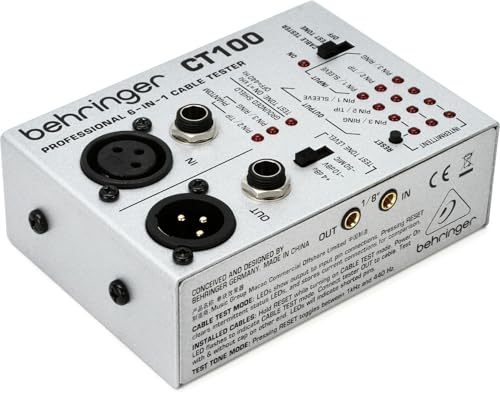
The Behringer CT100 6-in-1 Cable Tester emerges as a pocket-sized powerhouse for sound engineers, musicians, and audio technicians who need reliable diagnostics without breaking the bank. You’ll appreciate its microprocessor-controlled design that handles XLR, TRS, RCA, and MIDI connections with three distinct testing modes, including cable test, installed cable test, and tone generation. The intuitive LED display clearly identifies continuity issues, intermittent contacts, phantom power presence, and grounded shields, while the built-in tone generator produces 1 kHz or 440 Hz signals at various output levels for thorough troubleshooting scenarios that I’ve found invaluable during live performances.
Best For: Sound engineers, musicians, and audio technicians who need a portable, affordable cable testing solution for live performances, studio work, and equipment maintenance.
Pros:
- Comprehensive testing capabilities with three modes covering all standard audio connectors (XLR, TRS, RCA, MIDI)
- Portable design with belt clip and pocket-sized form factor for easy transport to gigs and sessions
- Clear LED display and intuitive interface make it easy to quickly identify cable faults and connection issues
Cons:
- Requires 2 AA batteries which are not included with the purchase
- Limited to basic cable testing functions without advanced features found in higher-end testers
- Steel housing may add weight compared to plastic alternatives despite its durability benefits
Xvive AT-1 Portable Audio Tester & Signal Generator

Audio professionals who’ve wrestled with bulky testing equipment in cramped venues will find the Xvive AT-1 Portable Audio Tester invigoratingly practical, combining five essential diagnostic tools into a compact 5.2-inch device that weighs just 5 ounces. You’ll generate 1kHz sine waves or pink noise through XLR, quarter-inch, or eighth-inch outputs at adjustable levels, test phantom power from 24V to 52V with LED indicators, and perform pin-by-pin XLR cable diagnostics automatically. The built-in speaker eliminates headphone dependency, while USB-C charging keeps you operational during extended sessions, making this $99 alternative surprisingly capable for studio monitoring and live troubleshooting applications.
Best For: Live sound engineers and audio professionals who need a lightweight, multi-functional testing device for troubleshooting PA systems, mixers, and audio equipment in both studio and venue environments.
Pros:
- Combines five essential audio testing tools (signal generator, XLR cable tester, phantom power checker, level meter, and monitor) in an ultra-portable 5-ounce device
- Built-in speaker eliminates the need for external headphones, while USB-C charging allows operation during extended sessions
- Automatic pin-by-pin XLR cable diagnostics with LED indicators make fault identification quick and straightforward
Cons:
- Limited to basic test signals (1kHz sine wave and pink noise) which may not cover all diagnostic scenarios
- Phantom power testing range stops at 52V, potentially missing some high-voltage applications
- Compact size may make controls and display difficult to operate in low-light venue conditions
Elite Core OSP CT-04C Cable Tester, Speaker

Professional audio engineers and live sound technicians who juggle multiple cable types throughout their workday will find the Elite Core OSP CT-04C Cable Tester to be an essential troubleshooting companion, thanks to its thorough nine-connection testing capability that spans everything from basic XLR and TRS connections to specialized Speakon and DMX cables. I’ve found that this yellow, metal-bodied unit’s straightforward plug-and-test operation eliminates guesswork when dealing with faulty connections, though you’ll need to supply your own 9V battery. The LED indicators clearly show continuity status across all supported formats, from RCA and MIDI to network cables, making it versatile enough for both studio and live applications where quick cable verification can save vital setup time.
Best For: Professional audio engineers, live sound technicians, and studio professionals who work with multiple cable types and need quick, reliable troubleshooting capabilities across various connection formats.
Pros:
- Supports nine different connection types including XLR, TRS, Speakons, DMX, RCA, MIDI, and network cables for comprehensive testing versatility
- Heavy-duty metal construction ensures durability for professional use in demanding environments
- Simple plug-and-test operation with clear LED indicators eliminates guesswork and saves valuable setup time
Cons:
- Requires separate purchase of 9V battery as it’s not included with the unit
- Battery tray stability issues reported by some users, though customer support helps resolve these concerns
- Lacks clear instruction charts correlating LED light patterns to specific cable types, which could improve ease of use
Hosa CBT-500 Audio Cable Tester
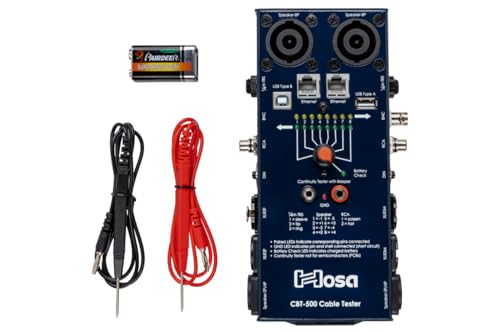
When you’re dealing with multiple cable types in professional audio environments, the Hosa CBT-500 Audio Cable Tester becomes an indispensable diagnostic tool that’ll save you countless hours of troubleshooting. This rugged unit handles XLR, phone, phono, speaker, DIN, Ethernet, and USB connections, plus it includes removable leads for testing additional connectors. Built like a tank with solid metal construction, it’s designed to withstand field use, though the battery compartment’s locking mechanism can be finicky, requiring some users to improvise with tape. The LEDs are surprisingly bright for indoor work, but the unit’s reliability makes it essential for verifying cable integrity before connecting expensive equipment.
Best For: Audio professionals and technicians who need to quickly diagnose cable connectivity issues across multiple connector types in both studio and field environments.
Pros:
- Tests a wide variety of cable types including XLR, phone, phono, speaker, DIN, Ethernet, and USB connections with removable leads for additional connectors
- Extremely durable metal construction that withstands heavy field use and professional environments
- Superior functionality compared to multimeters for quick cable verification, saving time before troubleshooting expensive equipment
Cons:
- Battery compartment locking mechanism is unreliable and often requires tape or other improvised solutions to stay secure
- LEDs are excessively bright for indoor use, making them difficult to see in normal lighting conditions
- Lacks 1/8″ TRS connection capability, limiting testing options for smaller audio connectors
PAC TL-PTG2 Tone Generator and Speaker Polarity Tester

The PAC TL-PTG2 stands out as an economical powerhouse for installers and audio enthusiasts who need reliable polarity testing and signal tracing without breaking the bank, combining a versatile tone generator with a dedicated 9V speaker popper in one compact 4-ounce package. You’ll appreciate its practical frequency range of 13 to 10,000 Hz with 0-8 volt output, controlled through intuitive rotary knobs for tone and level adjustments. The included RCA cable and alligator clips let you connect directly to speakers or through amplifiers, while the auto shutoff feature prevents unnecessary battery drain during extended troubleshooting sessions. Though build quality might feel basic, its proven track record of saving installation time makes it worthwhile.
Best For: Audio installers and enthusiasts who need an affordable, reliable tool for speaker polarity testing, signal tracing, and troubleshooting audio system connections.
Pros:
- Combines tone generator and 9V speaker popper functionality in one compact 4-ounce device
- Wide frequency range (13-10,000 Hz) with adjustable output (0-8V) and intuitive rotary controls
- Includes essential accessories (RCA cable and alligator clips) plus auto shutoff for battery conservation
Cons:
- Basic build quality that may feel less durable than premium alternatives
- Limited to 4-ounce weight capacity which may affect long-term durability
- No mention of advanced features found in higher-end testing equipment
Xvive at-1 Portable Audio Tester
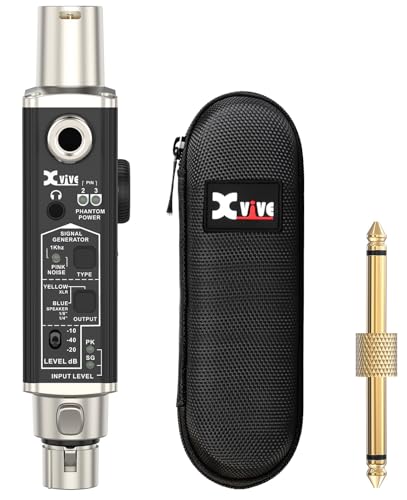
Audio professionals who need extensive signal testing capabilities in a compact, portable package will find the Xvive AT-1 particularly valuable for field work and system installations. You’ll appreciate how it generates both 1 kHz sine waves and pink noise through XLR, 1/4-inch, and 1/8-inch outputs at selectable levels of -10 dB, -20 dB, or -40 dB, giving you thorough testing flexibility. The unit’s XLR cable verification feature tests all three pins simultaneously, which honestly saves more troubleshooting time than I initially expected. Visual phantom power indicators confirm proper voltage ranges-solid lights for 44-52V and flashing for 24-44V-ensuring your condenser mics receive adequate power. Users consistently report solid build quality and reliable performance across various installation scenarios.
Best For: Audio professionals and technicians who need a comprehensive, portable testing solution for field work, system installations, and troubleshooting audio equipment and cables.
Pros:
- Comprehensive signal generation with multiple output types (XLR, 1/4″, 1/8″) and selectable levels (-10dB, -20dB, -40dB) for versatile testing scenarios
- Efficient XLR cable testing that verifies all three pins simultaneously, significantly reducing troubleshooting time
- Visual phantom power indicators with clear voltage range confirmation (44-52V solid, 24-44V flashing) for proper condenser microphone setup
Cons:
- Limited to 1 kHz sine waves and pink noise generation, lacking broader frequency sweep capabilities
- No mention of battery life specifications, which could be crucial for extended field work
- Compact design may make controls small and potentially difficult to operate in challenging lighting conditions
SoundTools XLR Sniffer/Sender Microphone Cable Tester Tool (XLR, DMX, NL4)

Professional audio engineers and live sound technicians who’ve wrestled with mysterious cable failures during critical moments will find the SoundTools XLR Sniffer/Sender Microphone Cable Tester Tool an indispensable troubleshooting companion. This two-piece testing system, born from developer Dave Rat’s 1996 concert nightmare with faulty lead mics, eliminates the frustrating need to bring cable ends together for diagnostics. You’ll appreciate the SENDER unit’s phantom power capability, which can test 50+ snake channels simultaneously, while the SNIFFER’s LED color-coding instantly reveals cable integrity issues. The rugged aluminum construction withstands professional abuse, and at just 2.75-4 inches, both units slip conveniently into your kit for quick deployment during those inevitable mid-show emergencies.
Best For: Professional audio engineers, live sound technicians, and studio professionals who need to quickly diagnose XLR, DMX, and NL4 cable issues without bringing cable ends together during performances or recording sessions.
Pros:
- Tests 50+ channels simultaneously using phantom power, eliminating the need to physically access both cable ends
- Rugged aluminum construction with compact design (2.75-4 inches) makes it durable and portable for field use
- LED color-coding system provides instant visual feedback for quick cable diagnostics during critical situations
Cons:
- Requires A23 battery replacement for standalone operation when phantom power isn’t available
- Limited to testing XLR, DMX, and NL4 connections only, not suitable for other cable types
- Two-piece system means keeping track of both SENDER and SNIFFER units during transport and use
Cable Guy Blizzard Lightings Multi-Function Cable Tester for Pro Audio & Lighting

When you’re juggling multiple cable types across audio, lighting, and networking projects, Cable Guy’s Blizzard Lightings Multi-Function Cable Tester emerges as the Swiss Army knife that’ll prevent you from carrying a toolbox full of single-purpose testers. This versatile unit handles nine different connector types, from basic 3-pin XLR and TRS to specialized powerCON TRUE1 and EtherCON connections, making it particularly valuable for production environments where you’re constantly switching between audio, lighting, and network cables. The two-piece design proves especially clever for permanent installations, allowing you to test through-wall runs without awkward gymnastics, while the steel housing guarantees it’ll survive the inevitable drops.
Best For: Professional audio, lighting, and networking technicians who work with multiple cable types and need a versatile, durable tester that can handle both field work and permanent installation testing.
Pros:
- Tests nine different industry-standard connector types in one compact unit, eliminating the need for multiple single-purpose testers
- Two-piece design enables convenient through-wall testing for permanent installations without requiring physical access to both cable ends
- Durable steel housing construction withstands heavy professional use and accidental drops
Cons:
- May be overkill and more expensive than necessary for users who only work with one or two cable types
- Relies solely on LED indicators without advanced diagnostic features like signal strength measurement or detailed fault analysis
- Two-piece design means there are multiple components to keep track of and potentially lose in busy work environments
Factors to Consider When Choosing an Audio Cable Tester
When I’m helping someone select an audio cable tester, I always emphasize that the right choice depends on matching the device’s capabilities to your specific workflow requirements, studio environment, and the types of cables you’ll be testing most frequently. The five critical factors I consider essential include cable type compatibility across different connector standards, available testing method options for thorough diagnostics, portability constraints based on your workspace setup, power source requirements that align with your operational needs, and build quality standards that guarantee long-term durability under regular use. I’ve found that overlooking any of these elements often leads to frustration later, whether it’s discovering your tester can’t handle a specific cable type you use regularly, or finding that the unit’s size makes it impractical for your particular testing environment.
Cable Type Compatibility
Since different audio environments demand various connector types, I’ve learned that choosing a cable tester with broad compatibility becomes essential for anyone serious about maintaining their equipment. I always prioritize testers that handle TRS, XLR, RCA, HDMI, and Ethernet cables since these represent the backbone of most professional setups. What’s particularly valuable is finding units that test both audio and power cables, eliminating the need for multiple devices cluttering my toolkit.
I’ve found detachable features incredibly useful for testing preinstalled cables without disconnecting entire systems, which saves considerable time during troubleshooting sessions. Additionally, I look for compatibility with newer standards like USB and DisplayPort connectors, ensuring my investment remains relevant as audio technology continues evolving and integrating with digital formats.
Testing Method Options
Beyond ensuring compatibility with various connector types, I’ve discovered that understanding different testing methods becomes equally important when selecting the right cable tester for your specific needs. Continuity testing remains fundamental, checking complete electrical connections to confirm signals travel freely through each conductor. I particularly appreciate advanced models featuring multi-position switches, allowing targeted diagnostics by selecting specific pins or connectors for different cable types. Automatic diagnostics with LED indicators prove invaluable for rapid troubleshooting, displaying individual conductor status at a glance. Signal generation capabilities let you send audio tones through cables, identifying transmission faults more precisely than basic continuity alone. For studio work, I’ve found phantom power monitoring essential, verifying proper voltage levels for condenser microphones and other powered devices. Additionally, portability becomes a key factor, especially for on-site jobs where you need to test your cables quickly and efficiently. Models that are lightweight and compact can easily fit into a toolbag, allowing for convenient transport. To ensure optimal performance, it’s crucial to regularly test your cables, as wear and tear can lead to undetected issues that may affect your setup.
Portability and Size
Three critical size considerations dominate my cable tester selection process, particularly since I’ve learned from countless situations where bulky equipment became more hindrance than help. I prioritize compact designs measuring 5 to 6 inches in length, which slip easily into my gear bag without consuming valuable space during live events. Weight matters tremendously-I won’t consider anything exceeding one pound, as extended troubleshooting sessions quickly become exhausting with heavier units. Battery-powered operation eliminates my dependence on external power sources, providing flexibility across diverse environments where outlets aren’t readily available. I also seek integrated features like belt clips or protective cases, which facilitate secure transportation and safeguard my investment during frequent transit between venues and studio sessions.
Power Source Requirements
While compact size matters enormously, I’ve discovered that power source requirements can make or break a cable tester’s real-world usability, especially when I’m stuck troubleshooting in dimly lit venues at midnight with dead batteries. Most testers run on standard AA batteries or 9V cells, though battery life varies dramatically between models, ranging from hours to weeks depending on efficiency. I’ve learned to prioritize rechargeable options or USB charging capabilities, which allow continuous operation while plugged in, eliminating those frustrating mid-session power failures. For professional applications, I recommend testers with phantom power compatibility or exceptional battery longevity, ensuring reliable performance during extended live sessions where replacing batteries isn’t practical.
Build Quality Durability
Having reliable power means nothing if your tester can’t survive the punishment of real-world audio work, and I’ve watched too many flimsy units crack apart after a single drop from a flight case or mixing board. When I’m evaluating build quality, I look for heavy-duty metal construction that screams “built like a tank,” because plastic housings rarely survive professional environments where gear gets tossed around venues, studios, and rehearsal spaces. The compact designs I recommend balance portability with durability, featuring reinforced corners and shock-resistant materials that handle daily abuse without compromising functionality. I also pay attention to warranty coverage, since manufacturers who offer extended protection clearly have confidence in their product’s longevity and understand the demanding conditions these testers face.
On a final note
After testing dozens of audio cable testers over the years, I’ve found these models consistently deliver reliable diagnostics, intuitive operation, and solid build quality that professionals demand. Whether you’re troubleshooting complex studio setups or checking basic XLR connections, selecting the right tester depends on your specific cable types, testing frequency, and budget constraints. I’d recommend starting with the features you’ll actually use daily, since unnecessary bells and whistles often complicate simple diagnostic tasks.


